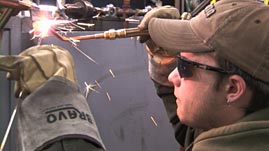Teachers' Domain - Digital Media for the Classroom and Professional Development
User: Preview

Source: Pennsylvania College of Technology/WVIA
This video segment adapted from Pennsylvania College of Technology and WVIA examines welding, a profession that currently employs about 500,000 people in the United States. Due to an aging infrastructure that includes highway systems and bridges in need of maintenance and expansion, welders are expected to be in heavy demand over the next several years. The video demonstrates welding techniques, explains the consequences of bad welds and how to recognize when a bad weld has been made, and identifies different pathways to a welding career.
Welding is the process that joins two materials, usually metals or plastics, by melting their surfaces together. When done correctly, welding creates a permanent, airtight and watertight bond that is much stronger than what bolts or adhesives can achieve. Welding is extremely important to many industrial processes. Because of the strength it affords, welding is used in manufacturing car, ship, and airplane bodies. It also is used to join beams in building and bridge construction, and to join pipes in pipelines and fuel refineries.
For centuries, blacksmiths joined iron and steel by heating and then hammering them repeatedly until bonding occurred. The heat required for today's more advanced welding techniques is generated by such sources as electrical currents, lasers, and vibrations. To make a standard weld, enough heat must be applied to liquefy the surfaces of the parts to be joined. A molten filler material must also be added at the welding point, where the two parts meet. As the mixed components cool, they solidify with a strong joint—the weld—bonding them together. Because oxygen and nitrogen present in the air can get trapped as bubbles in a joint as it forms and weaken it, it is very important to keep these gases out of the weld area. Therefore, many welding processes provide a means of covering the welding point with a protective shield of chemically nonreactive gas.
The most commonly used welding processes are variations of arc welding. Arc welding refers to any process that uses a power supply to create an electric arc between an electrode and the base material, to melt the metals at the welding point. Arc welding is widely used because it is cheap relative to other forms of welding and versatile, making it well suited to both factory-floor work and field work. That said, because the electrodes must be replaced frequently and the process leaves a residue that must be chipped away after welding, arc welding can be a slow process.
Another form of welding that is widely used in car manufacturing and repair is resistance welding. In resistance welding, electric current is run through electrodes connected to the two overlapping surfaces to be joined. The materials resist the current, causing small pools of molten metal to form at the weld area.
To judge the quality of a weld, a tester must verify that the weld is free of defects and has low levels of residual stresses and distortion, which are routinely caused by such energy-intensive processes. Welding codes and specifications exist to help welders judge the quality of their welds. Some common causes for mistakes in welding include improper cleaning of parts and weld surfaces, failing to adequately shield the welding area from the wind, and selecting too small a welding machine for the thickness of materials to be joined.
 Loading Standards
Loading Standards Teachers' Domain is proud to be a Pathways portal to the National Science Digital Library.
Teachers' Domain is proud to be a Pathways portal to the National Science Digital Library.
